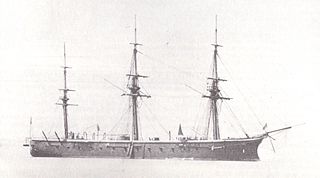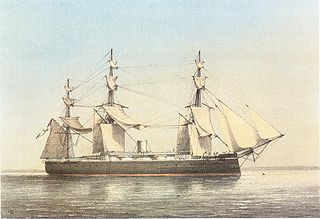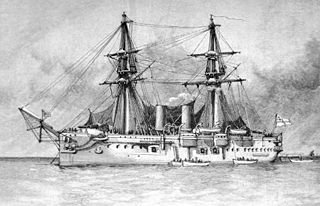
A ship of the line was a type of naval warship constructed during the Age of Sail from the 17th century to the mid-19th century. The ship of the line was designed for the naval tactic known as the line of battle, which involved the two columns of opposing warships maneuvering to volley fire with the cannons along their broadsides. In conflicts where opposing ships were both able to fire from their broadsides, the opponent with more cannons firing – and therefore more firepower – typically had an advantage.

The first HMS Wivern was an ironclad turret ship built at Birkenhead, England. She was one of two sister ships secretly ordered from the John Laird Sons & Company shipyard in 1862 by the Confederate States of America.

An ironclad is a steam-propelled warship protected by iron or steel armor plates, constructed from 1859 to the early 1890s. The ironclad was developed as a result of the vulnerability of wooden warships to explosive or incendiary shells. The first ironclad battleship, Gloire, was launched by the French Navy in November 1859 – narrowly pre-empting the British Royal Navy, though Britain built the first completely iron-hulled warships.

The seventh HMS Enterprise of the Royal Navy was an armoured sloop launched in 1864 at Deptford Dockyard. Originally laid down as a wooden screw sloop of the Camelion class, she was redesigned by Edward Reed and completed as a central battery ironclad. The ship spent the bulk of her career assigned to the Mediterranean Fleet before returning to England in 1871 where she was paid off. Enterprise was sold for scrap in 1885.

HMS Iron Duke was the last of four Audacious-class central battery ironclads built for the Royal Navy in the late 1860s. Completed in 1871, the ship was briefly assigned to the Reserve Fleet as a guardship in Ireland, before she was sent out to the China Station as its flagship. Iron Duke returned four years later and resumed her duties as a guardship. She accidentally rammed and sank her sister ship, Vanguard, in a heavy fog in mid-1875 and returned to the Far East in 1878. The ship ran aground twice during this deployment and returned home in 1883. After a lengthy refit, Iron Duke was assigned to the Channel Fleet in 1885 and remained there until she again became a guardship in 1890. The ship was converted into a coal hulk a decade later and continued in that role until 1906 when she was sold for scrap and broken up.

The eighth HMS Shannon was the first British armoured cruiser. She was the last Royal Navy ironclad to be built which had a propeller that could be hoisted out of the water to reduce drag when she was under sail, and the first to have an armoured deck.

HMS Defence was the lead ship of the Defence-class armoured frigates ordered by the Royal Navy in 1859. Upon completion in 1862 she was assigned to the Channel Fleet. The ship was paid off in 1866 to be refitted and rearmed and was briefly reassigned to the Channel Fleet when she recommissioned in 1868. Defence had short tours on the North Atlantic and Mediterranean Stations, relieving other ironclads, from 1869 to 1872 before she was refitted again from 1872 to 1874. She became guard ship on the River Shannon when she recommissioned. The ship was transferred to the Channel Fleet again in 1876 and then became guard ship on the River Mersey until 1885. Defence was placed in reserve until 1890, when she was assigned to the mechanical training school in Devonport in 1890. She was renamed Indus when the school adopted that name and served there until sold for scrap in 1935.

The Defence-class ironclads were a class of two warships built for the Royal Navy between 1859 and 1862. The ships were designed as armoured frigates in response to an invasion scare sparked by the launch of the French ironclad Gloire and her three sisters in 1858. They were initially armed with a mix of rifled breech-loading and muzzle-loading smoothbore guns, but the Armstrong breech-loading guns proved unreliable and were withdrawn from service after a few years.

HMS Caledonia was a broadside ironclad of the Prince Consort class. Originally laid down as a two-decker steam ship of the line of the Bulwark class, Caledonia was converted on the building stocks into an armoured frigate.

HMS Research was a small ironclad warship, converted from a wooden-hulled sloop and intended as an experimental platform in which to try out new concepts in armament and in armour. She was launched in 1863, laid up in 1878 and sold for breaking in 1884, having displayed serious limitations as a warship.

The two Scorpion-class ironclads, HMS Scorpion and HMS Wivern, were ironclad warships ordered by the Confederate States Navy in 1862 and seized in 1863 by the British to prevent their delivery. This would have violated the Foreign Enlistment Act, which forbade British subjects to build or arm any ships for governments at war with governments friendly to Great Britain. The Scorpion class were masted turret ships, each with two gun turrets that were designed to mount a pair of heavy muzzle-loading guns. They were purchased for service in the Royal Navy in 1864 and served briefly with the Channel Fleet before they became guard ships at Bermuda and Hong Kong. Scorpion was sold in 1903 and sank under tow to be scrapped, while Wivern was sold for scrap in 1922.

HMS Bellerophon was a central battery ironclad built for the Royal Navy in the mid-1860s.

HMS Hercules was a central-battery ironclad of the Royal Navy in the Victorian era, and was the first warship to mount a main armament of 10-inch (250 mm) calibre guns.

HMS Monarch was the first seagoing British warship to carry her guns in turrets, and the first British warship to carry guns of 12-inch (300 mm) calibre.

HMS Sultan was a broadside ironclad of the Royal Navy of the Victorian era, who carried her main armament in a central box battery. She was named for Sultan Abdulaziz of the Ottoman Empire, who was visiting England when she was laid down. Abdulaziz cultivated good relations with the Second French Empire and the British. In 1867 he was the first Ottoman sultan to visit Western Europe; his trip included a visit to England, where he was made a Knight of the Garter by Queen Victoria and shown a Royal Navy Fleet Review, with Isma'il Pasha of Egypt.

HMS Alexandra was a central battery ironclad of the Victorian Royal Navy, whose seagoing career was from 1877 to 1900. She spent much of her career as a flagship, and took part in operations to deter the Russian Empire's aggression against the Ottoman Empire in 1878 and the bombardment of Alexandria in 1882. She was affectionately known by her crew as Old Alex.

HMS Temeraire was an ironclad battleship of the Victorian Royal Navy which was unique in that she carried her main armament partly in the traditional broadside battery, and partly in barbettes on the upper deck.

SMS König Wilhelm was an armored frigate of the Prussian and later the German Imperial Navy. The ship was laid down in 1865 at the Thames Ironworks shipyard in London, originally under the name Fatih for the Ottoman Empire. She was purchased by Prussia in February 1867, launched in April 1868, and commissioned into the Prussian Navy in February 1869. The ship was the fifth ironclad ordered by the Prussian Navy, after Arminius, Prinz Adalbert, Friedrich Carl, and Kronprinz. She was built as an armored frigate, armed with a main battery of sixteen 24 cm (9.4 in) and five 21 cm (8.3 in) guns; several smaller guns and torpedo tubes were added later in her career.

San Martino was a Regina Maria Pia-class ironclad warship, the second member of her class. She was built for the Italian Regia Marina in the 1860s; like her three sister ships, she was built in France. San Martino was laid down in July 1862, was launched in September 1863, and was completed in November 1864. The ships were broadside ironclads, mounting a battery of four 203 mm (8 in) and twenty-two 164 mm (6.5 in) guns on the broadside.

















